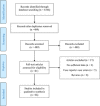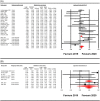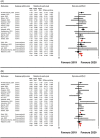The global impact of COVID-19 pandemic on the incidence of pediatric new-onset type 1 diabetes and ketoacidosis: A systematic review and meta-analysis
- PMID: 35831242
- PMCID: PMC9350204
- DOI: 10.1002/jmv.27996
The global impact of COVID-19 pandemic on the incidence of pediatric new-onset type 1 diabetes and ketoacidosis: A systematic review and meta-analysis
Abstract
Viral infections may increase the risk of developing type 1 diabetes (T1D), and recent reports suggest that Coronavirus Disease 2019 (COVID-19) might have increased the incidence of pediatric T1D and/or diabetic ketoacidosis (DKA). Therefore, this meta-analysis aims to estimate the risk of global pediatric new-onset T1D, DKA, and severe DKA before and after the COVID-19 pandemic. A systematic search of MEDLINE/PubMed, CINAHL, Scopus, and EMBASE was conducted for articles published up to March 2022. A random-effects meta-analysis was performed to compare the relative risk of T1D and DKA among pediatric patients with T1D between the COVID-19 pre-pandemic and pandemic periods. We also compared glucose and HbA1c values in children who were newly diagnosed with T1D before and after the COVID-19 pandemic. The global incidence rate of T1D in the 2019 period was 19.73 per 100 000 children and 32.39 per 100 000 in the 2020 period. Compared with pre-COVID-19 pandemic, the number of worldwide pediatric new-onset T1D, DKA, and severe DKA during the first year of the COVID-19 pandemic increased by 9.5%, 25%, and 19.5%, respectively. Compared with pre-COVID-19 pandemic levels, the median glucose, and HbA1c values in newly diagnosed T1D children after the COVID-19 pandemic increased by 6.43% and 6.42%, respectively. The COVID-19 pandemic has significantly increased the risk of global pediatric new-onset T1D, DKA, and severe DKA. Moreover, higher glucose and HbA1c values in newly diagnosed T1D children after the COVID-19 pandemic mandates targeted measures to raise public and physician awareness.
Keywords: COVID-19; exercise; meta-analysis; physical activity.
© 2022 Wiley Periodicals LLC.
Conflict of interest statement
The authors declare no conflict of interest.
Figures




Comment in
-
Comments on Rahmati et al., The global impact of COVID-19 pandemic on the incidence of pediatric new-onset type 1 diabetes and ketoacidosis: A systematic review and meta-analysis. J Med Virol. 2022; 1-16 (doi: 10.1002/jmv.27996).J Med Virol. 2023 Jan;95(1):e28272. doi: 10.1002/jmv.28272. Epub 2022 Nov 14. J Med Virol. 2023. PMID: 36324006 Free PMC article. No abstract available.
References
-
- Hyöty H. Viruses in type 1 diabetes. Pediatr Diabetes. 2016;17:56‐64. - PubMed
-
- Holt RI, Cockram C, Flyvbjerg A, Goldstein BJ. Textbook of diabetes. John Wiley & Sons; 2017.
Publication types
MeSH terms
Substances
LinkOut - more resources
Full Text Sources
Medical

